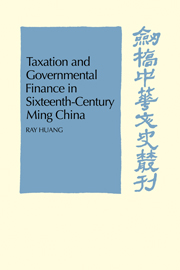Book contents
- Frontmatter
- Contents
- List of figures
- List of tables
- Preface by D. C. Twitchett
- Acknowledgements
- A note on weights and measures
- The Ming emperors
- Map of Ming provinces
- 1 Fiscal organization and general practices
- 2 The heritage of the sixteenth century and major fiscal problems
- 3 The land tax—(i) Tax structure
- 4 The land tax—(ii) Tax administration
- 5 The salt monopoly
- 6 Miscellaneous incomes
- 7 Financial management
- 8 Concluding observations
- List of abbreviations
- Appendixes
- Notes to the text
- Bibliography
- Glossary index
- General index
Preface by D. C. Twitchett
Published online by Cambridge University Press: 04 August 2010
- Frontmatter
- Contents
- List of figures
- List of tables
- Preface by D. C. Twitchett
- Acknowledgements
- A note on weights and measures
- The Ming emperors
- Map of Ming provinces
- 1 Fiscal organization and general practices
- 2 The heritage of the sixteenth century and major fiscal problems
- 3 The land tax—(i) Tax structure
- 4 The land tax—(ii) Tax administration
- 5 The salt monopoly
- 6 Miscellaneous incomes
- 7 Financial management
- 8 Concluding observations
- List of abbreviations
- Appendixes
- Notes to the text
- Bibliography
- Glossary index
- General index
Summary
When some twenty years ago I finished the first draft of my own study of T'ang financial administration, I began to undertake the preliminary reading for a similar study of the Ming period, feeling that it would be possible to pose and answer many questions which cannot even be formulated in detail for earlier periods because of the lack of evidence.
I soon found myself frustrated by the complexity of the task. The sheer bulk of source material which has to be covered is daunting in itself, and since then far more of the Ming historical literature has been made generally accessible. But in addition the subject matter proved to be infinitely more complicated than in the case of the T'ang. The main problem was that whereas the earlier dynasties had systematically attempted to impose a uniform and universal set of comparatively simple institutions throughout their empire, and incorporated these in a tightly drafted system of centrally codified administrative law, the gradual abandonment of this concept of uniform government from the late eighth century onwards, and the decentralization of control over detailed policy-making and enforcement, had led by Ming times to a situation of bewildering local diversity. It had reached the point where in some fields it was no longer possible to make simple generalizations about the empire as a whole. Eventually I was side-tracked into other things and abandoned my plans.
- Type
- Chapter
- Information
- Publisher: Cambridge University PressPrint publication year: 1975



